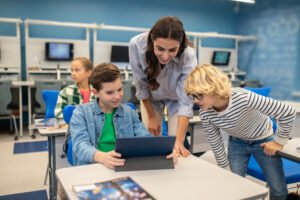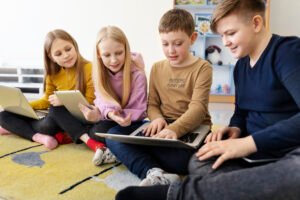
How School Leaders Can Prevent Teacher Burnout
Discover how school leaders can take meaningful steps to prevent teacher burnout and create healthier, more supportive learning environments.

Teaching effective reading comprehension strategies is the most critical means of helping students develop successful reading skills. Reading comprehension in today’s classroom is not reading words—making sense, thinking, and applying information across the curriculum. In this blog, we are going to discuss effective reading strategies and how-to advice to increase student comprehension using real-world, easy-to-implement strategies.
Reading comprehension is the cornerstone of meaningful learning in all subjects and goes beyond simply decoding words. To succeed academically and personally, students need to be able to comprehend, interpret, and apply information in any subject, including science, history, and mathematics.
Teaching direct comprehension techniques like summarizing, predicting, and questioning must be incorporated into early reading instruction in addition to teaching fundamental reading skills. Students require ongoing assistance as they move into middle and high school in order to tackle challenging texts and develop their critical thinking abilities.
Reasoning, communication, problem-solving, and independent learning are all vital life skills that are developed through strong reading comprehension. Being able to assess and analyze what one reads has become even more important in a world where information is abundant. Comprehension-trained students are more equipped for challenges in the workplace, further education, and civic engagement.
Priority to the understanding of reading is a long -term investment. Schools that give priority not only are producing strong students, but are also developing competent, considering individuals who are ready to flourish in a world that are changing quickly. By integrating effective strategies in your ELA lesson plans, the school can ensure that students create important reading and thinking skills necessary for lifetime success.
The way we contact literacy in the classroom has developed quite a great development. Today, teaching reading is no longer limited to developing flow or mastery in phonetics. It has expanded to focus on helping students to understand and analyze complex texts, whether in print or online. Literacy now demands more than the ability to accurately read words; This requires the ability to understand, interpret and apply information in a wide range of subjects.
With increased assessment and increased emphasis on cross-disciplinary learning, students are expected to attach to the idea seriously. They must be able to evaluate information to make sense, make connections and succeed in various academic fields. As a result, the role of teachers has also expanded. Teachers should now include the understanding of effective reading and communication strategies in their instructions to ensure that students fulfill the rigorous demands of modern education.
Today, teaching literacy means not only preparing students to read, but also to think deeply about what they study. By embedding ELA (English language art) in daily lessons, school students can equip the students with significant skills they need to succeed in school, in their future career, and as lifelong learners.
Students need context before entering into a new text. As they link what they are going to read with what they already know, learning is made meaningful. This little trick makes reading easier to comprehend and meaningful.
Getting students to ask as they read transforms them from being passive readers into active thinkers. By having students ask their own questions, their knowledge becomes deeper by default.
Use Reciprocal Teaching: Students move through roles—the questioner, summarizer, clarifier, predictor—to direct discussions in small groups.
Provide Question Stems: Offer students sentence starters like “Why do you think.” or “What might happen if…?” to help students build good questions.
Practice in Guided Reading Groups: Stop frequently in small groups and instruct students to question characters, plot, or vocabulary.
The majority of students are visual learners, and visualization helps them visualize what they are reading. They remember more and are engaged when they visualize characters, settings, or actions.
Attempt Sketch-to-Stretch Activities: Following reading, have students sketch a scene or idea and describe their drawing. This links art with understanding.
Create Mind Maps: Use visual webs to chart character traits, plot development, or theme relationships throughout the novel.
Encourage Imagery-Based Thinking: Have students close their eyes and describe what they see occurring in important sections of the story.
To model “thinking aloud,” students get to listen to what good readers think to themselves. By guiding them through the process, teachers can make skills that are invisible become real.
Tell them to make teachers pause and comment things like, “I wonder why the character did that,” or “This reminds me of…”
Use the Gradual Release Model: Model the skill first, practice it with you second, and finally let students try it independently.
Have Students Think-Aloud: Following the modeling, have students think-aloud in pairs or small groups.
Reading does not have to be done alone. Discussion enables students to listen to new ideas, experiment with ideas, and eliminate misunderstanding. When students discuss the reading, they know more.
Tell them to make teachers pause and comment things like, “I wonder why the character did that,” or “This reminds me of…”
Use Literature Circles: Divide each student into a role—discussion director, connector, summarizer—and rotate weekly. This keeps discussions in order and inclusive.
Experiment with Socratic Seminars: Have open-ended conversations where students discuss large questions regarding the text.
Do Turn and Talks: Following a brief reading segment, students will have a brief discussion with a partner prior to moving on.
One should recognize that the reading strategy should be read. Most students, both good and struggling readers, struggle to create an understanding of challenging texts. The understanding of reading like mathematics or science should be practiced. When reading is taught at primary or middle school levels, the creation of these skills is important by step. In alignment with the main core curriculum standards Ela, it becomes necessary to ensure that understanding strategies are systematically created in daily instructions. Despite the student’s current reading level, these strategies provide structured ways to create and achieve important thinking and understanding necessary for academic success.
The good news is, you don’t need to redesign your curriculum to put these practices into action. Small, sustained efforts can have big payoffs.
Use Strategy Bell-Ringers: Begin the day with a quick question, visualization, or connection activity based on the day’s reading.
Exit Tickets with Purpose: Ask students to think about things like, “What did you envision today?” or “What’s still on your mind?”
Rotate Strategy Stations: Create reading stations emphasizing various strategies—questioning, drawing, thinking aloud—to practice each week.
Reading is not a native talent – it learn some students with time, guidance and correct equipment. By teaching the understanding of these five reading strategies, teachers can give all the learners the power to increase confidence and capacity at all levels. When students combine the former knowledge, give rise to important questions, imagine what they read, listen to modeling thinking, and discuss with others, they become active thinkers and not inactive readers.
These strategies, which are often integrated into a strong life skill curriculum, can be applied to grade levels and subject areas. Whether you are instructing middle school or elementary school literacy, you can make each strategy friendly to your students’ requirements. The most important thing is that you do not require a completely new course to bring change – the dimensional, habitual application of these devices will usually be sufficient to create real improvements.
Test One Technique Today Don’t wait for the perfect moment—experiment with one approach and pilot it this week! Start small: have a think-aloud during a read-aloud, or book a free personalized TomoClub or email at info@tomoclub.org

Discover how school leaders can take meaningful steps to prevent teacher burnout and create healthier, more supportive learning environments.

Explore how teaching AI to students equips them with future-ready skills in a tech-driven world. Learn six practical strategies teachers can use to build AI literacy in the classroom effectively and responsibly.

Explore how artificial intelligence is reshaping classrooms across the globe-from customizing student learning to streamlining teacher workloads

Explore how AI is transforming school administration-cutting routine tasks and empowering educators to focus more on students and innovation.
Explore insightful articles and updates that keep you abreast of the evolving landscape of education, ensuring you stay ahead in your educational journey.